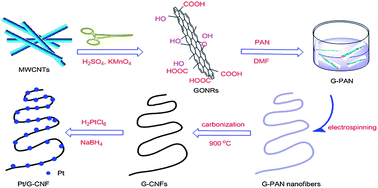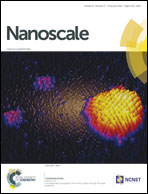Graphene nanoribbons hybridized carbon nanofibers: remarkably enhanced graphitization and conductivity, and excellent performance as support material for fuel cell catalysts†
Abstract
High electronic conductivity of the support material and uniform distribution of the catalyst nanoparticles (NPs) are extremely desirable for electrocatalysts. In this paper, we present our recent progress on electrocatalysts for fuel cells with simultaneously improved conductivity of the supporting carbon nanofibers (CNFs) and distribution of platinum (Pt) NPs through facile incorporation of graphene nanoribbons (GNRs). Briefly, GNRs were obtained by the cutting and unzipping of multiwalled carbon nanotubes (MWCNTs) and subsequent thermal reduction and were first used as novel nanofillers in CNFs towards high performance support material for electrocatalysis. Through electrospinning and carbonization processes, GNR embedded carbon nanofibers (G–CNFs) with greatly enhanced graphitization and electronic conductivity were synthesized. Chemical deposition of Pt NPs onto G–CNFs generated a new Pt–G–CNF hybrid catalyst, with homogeneously distributed Pt NPs of ∼3 nm. Compared to Pt–CNF (Pt on pristine CNFs) and Pt–M–CNF (Pt on MWCNT embedded CNFs), Pt–G–CNF hybrids exhibit significantly improved electrochemically active surface area (ECSA), better CO tolerance for electro-oxidation of methanol and higher electrochemical stability, testifying G–CNFs are promising support materials for high performance electrocatalysts for fuel cells.


 Please wait while we load your content...
Please wait while we load your content...